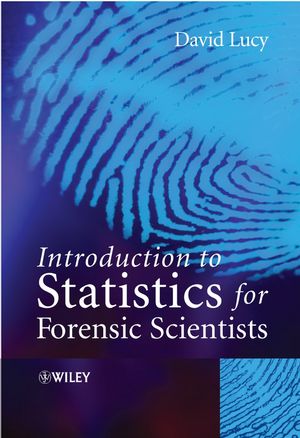Introduction to Statistics for Forensic ScientistsISBN: 978-0-470-02200-9
Hardcover
266 pages
December 2005
 This is a Print-on-Demand title. It will be printed specifically to fill your order. Please allow an additional 15-20 days delivery time. The book is not returnable.
Other Available Formats: Paperback
|
||||||
List of Figures.
1. A short history of the statistics in the law.
1.1 History.
1.2 Some recent uses of statistics in forensic science.
1.3 What is probability?.
2. Data types, location and dispersion.
2.1 Types of data.
2.2 Populations and samples.
2.3 Distributions.
2.4 Location.
2.5 Dispersion.
2.6 Hierarchies of variation.
3. Probability.
3.1 Aleatory probability.
One throw of a six-sided die.
A single throw with more than one outcome of interest.
Two-sided dice.
3.2 Binomial probability.
3.3 Poisson probability.
3.4 Empirical probability.
Modelled empirical probabilities.
Truly empirical probabilities.
4. The normal distribution.
4.1 The normal distribution.
4.2 Standard deviation and standard error of the mean.
4.3 Percentage points of the normal distribution.
4.4 The t-distribution and the standard error of the mean.
4.5 t-testing between two independent samples.
4.6 Testing between paired observations.
4.7 Confidence, significance and p-values.
5. Measures of nominal and ordinal association.
5.1 Association between discrete variables.
5.2 X2 test for 2 x 2 table.
5.3 Yules Q.
5.4 X2 tests for greater than 2 x 2 tables.
5.5 02 and Cramers V2.
5.6 The limitations of X2 testing.
5.7 Interpretation and conclusions.
6. Correlation.
6.1 Significance tests for correlation coefficients.
6.2 Correlation coefficients for non-linear data.
6.3 The coefficient of determination.
6.4 Partial correlation.
6.5 Partial correlation controlling for two or more covariates.
7. Regression and calibration.
7.1 Linear models.
7.2 Calculation of a linear regression model.
7.3 Testing 'goodness of fit'.
7.4 Testing coefficients a and b.
7.5 Residuals.
7.6 Calibration.
A linear calibration model.
Calculation of a confidence interval for a point.
7.7 Points to remember.
8. Evidence evaluation.
8.1 Verbal statements of evidential value.
8.2 Evidence types.
8.3 The value of evidence.
8.4 Significance testing and evidence evaluation.
9. Conditional probability and Bayes' theorem.
9.1 Conditional probability.
9.2 Bayes' theorem.
9.3 The value of evidence.
10. Relevance and the formulation of propositions.
10.1 Relevance.
10.2 Hierarchy of propositions.
10.3 Likelihood ratios and relevance.
10.4 The logic of relevance.
10.5 The formulation of propositions.
10.6 What kind of propositions can we not evaluate?.
11. Evaluation of evidence in practice.
11.1 Which database to use.
Type and geographic factors.
DNA and database selection.
11.2 Verbal equivalence of the likelihood ratio.
11.3 Some common criticisms of statistical approaches.
12. Evidence evaluation examples.
12.1 Blood group frequencies.
12.2 Trouser fibres.
12.3 Shoe types.
12.4 Airweapon projectiles.
12.5 Height description from eyewitness.
13. Errors in interpretation.
13.1 Statistically based errors of interpretation.
Transposed conditional.
Defender's fallacy.
Another match error.
Numerical conversion error.
13.2 Methodological errors of interpretation.
Different level error.
Defendant's database fallacy.
independence assumption.
14. DNA I.
14.1 Loci and alleles.
14.2 Simple case genotypic frequencies.
14.3 Hardy-weinberg equilibrium.
14.4 Simple case allelic frequencies.
14.5 Accounting for sub-populations.
15. DNA II.
15.1 Paternity - mother and father unrelated.
15.2 Database searches and value of evidence.
15.3 Discussion.
16. Sampling and sample size estimation.
16.1 Estimation of a mean.
16.2 Sample sizes for t-tests.
Two sample t-test.
One sample t-test.
16.3 How many drugs to sample.
16.4 Concluding comments.
17. Epilogue.
17.1 Graphical models and bayesian networks.
Graphical models.
Bayesian networks.
17.2 Kernel density estimation.
17.3 Multivariate continuous matching.
Appendix A: Worked solutions to questions.
Appendix B: Percentage points of the standard normal distribution.
Appendix C: Percentage points of t-distributions.
Appendix D: Percentage points of X2-distributions.
Appendix E: Percentage points of beta-beta distributions.
Appendix F: Percentage points of f-distributions.
Appendix G: Calculating partial correlations using excel software.
Appendix H: Further algebra using the "third law".
References.
Index.



